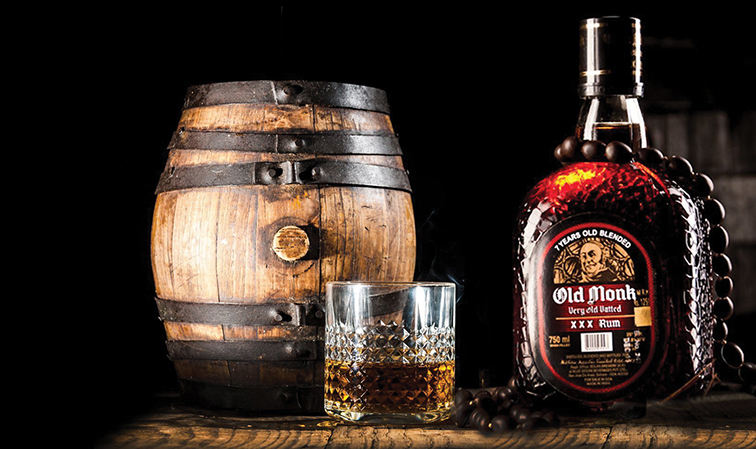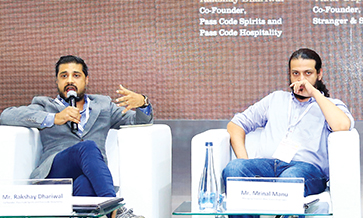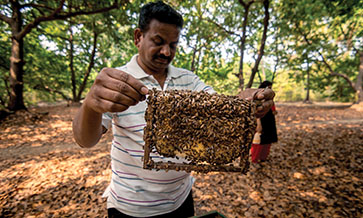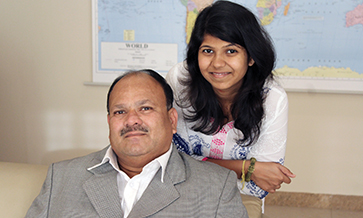Globally consumed, but under-valued, rums are finding their rightful place under the sun, far beyond the tropical colonies in which they were born
In 2015, I visited the German Rum Fest in Berlin. I was taken aback by the proliferation of rums from all over the world, all with fascinating stories to tell – from Nine Leaves rum of Japan, to The Real Mccoy from Barbados, and Seven Fathoms rum from the Cayman Islands.
Brazil was a partner country to the Rum Fest that year, and it was sheer joy to sample the range of different Cachaca on offer. The German Rum Fest for me was an eye-opener for a beverage that I had mostly taken for granted till then.
Rum is one of the most global of spirits, produced and consumed all around the world. But it is probably also one of the most under-valued, with a severe perception problem.
In most countries, including in the Caribbean, the birthplace of rum, premium rums have struggled to get a foothold due to the prevalent rum culture veering towards easy-drinking rums, suited for a party culture.
In recent years, spirits such as Tequila, gin and Cognac have attracted global celebrities to back brands in these categories, with profitable results for the brand owners. The most recent example is that of actor Ryan Reynolds supporting Aviation Gin, which was recently acquired by Diageo, for over US$ 600 million!
Rum has so far seen no such celebrity cachet attached to it. The situation is no different in India, where the abundance of sugarcane, combined with other legacy reasons, has led to a flood of inexpensive rums in the market.
‘Value’ segment
The explosion of craft gin may be attributed to well-travelled Indian consumers exposed to global trends, and a slew of home-grown brands that combined product excellence with superior brand values.
And even though rum is a 42.5-million-case market in India (as per IWSR 2019 report), 92% of these volumes are in the entry-level dark rum category. The brands are primarily in the “value” segment in the Rs. 300-400 range.
The dominant ones are Diageo’s McDowell’s Celebration (14 million cases) and the influential Old Monk. As Amar Sinha, COO of Radico Khaitan says, “Rum sales in India have historically been driven by the Canteen Stores Department for the defence services and consumers in southern and eastern India, mostly dominated by mass brands.”
Dark rum – and more specifically Old Monk – is a legacy drink for Baby Boomers and GenX. At home bars of even CEOs one sees bottles of Old Monk rubbing shoulders with the fanciest of Scotch. “What we need now,” says Keshav Prakash of Mumbai's The Vault Collection, “is the POM (post-Old Monk) generation to emerge.”
“Spirits categories nowadays have shorter shelf lives than before. The Millennials and pre-Millennials that made gin are not loyalists to any category or brand, and that will work in rum’s favour,” he feels.
We see, therefore, craft rums emerge, such as the Real Mccoy or Scotland’s Dark Matter spiced rum. So too are we seeing artisanal colas and ginger beers appear to complement rum, the same way as we saw a tonic boom accompany the gin craze.
As Dawn Davies, head buyer for London-based The Whisky Exchange says, “For me, rum is currently the most exciting category out there. It’s a spirit that’s always had so much happiness and vibrancy about it; and now it’s a category that’s seeing so much innovation too.”
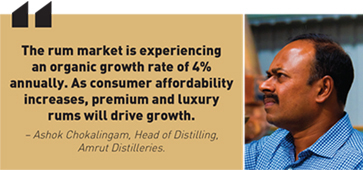
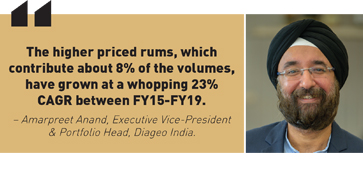
Colour conscious
Rum has other challenges to overcome, including some popular myths that it’s a winter drink, or that it is primarily consumed by the military. Old Monk also, in a sense, implanted a certain taste of rum for consumers, who wondered why they needed to pay a premium for another product when they were already perfectly happy with what they had.
It was not just taste, but also a lasting perception of what colour rum should be. As Rahul Gagerna of BS Brands, who has launched a dark rum, Gladus, says, “For the customer, a rum has to be a dark rum.”
There is, therefore, also a strong colour perception to be overcome if other styles of rum are to make any headway. Multinationals have also launched their international brands in the past in the dark, gold and spiced segments, but have not met with much success.
Keshav (The Vault) feels, however, that a high-quality dark rum that can take on Old Monk in a blind test has a good chance of consumer acceptance, especially for the POM generation.
Pushpanjali Banerji, Brand Director at Kyndal Group, says several of these brands were rejected either because there was a lack of patience in developing the category and brand, or else that the premium cachet enjoyed by the brand in an international market was diminished in India.
Brands vied for a part of the mass market rather than establishing a distinct premium segment for themselves and a step up the ladder, she adds.
Kyndal has recently launched a dark rum called Bootz in association with its partners, Bols from the Netherlands. Bootz is a blend of Jamaican and Indian rums and is priced at a substantial premium to Old Monk in a market like Delhi, a leap of faith when it comes to pricing. It has been rewarded by the quality seeking customers.
“Bootz is not focusing on upgrading the regular dark rum consumer. Instead, it targets those consumers whose first drink may have been a premium whiskey or white spirit and who would also like quality rum to drink,” Pushpanjali says.
She seconds Keshav’s hypothesis by saying that Millennials and even Baby Boomers are open to trying new things.
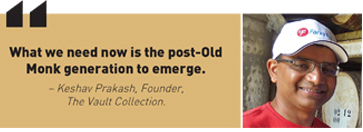
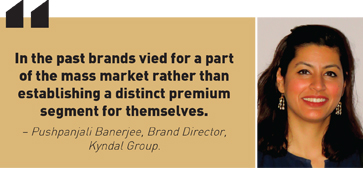
Stupendous growth
According to Amarpreet Anand, Executive Vice-President and Portfolio Head at Diageo India, “Millennials and Gen-Z socialize differently, with alcoholic beverages playing the role of participating in the socialising experience, and not always being the primary reason to meet. Drinking better is critical for this cohort, where drinks also allow for some degree of experimentation.”
Amar Sinha (Radico) says that as consumer’s disposable incomes have grown, they have looked for more premium and aspirational products, but have unfortunately not been able to find that in the rum category.
Ashok Chokalingam of Amrut Distilleries says his company has Two Indies, a gold rum in the premium segment, and the dark Old Port rum in the regular segment. “The rum market is experiencing an organic growth rate of 4% annually, as consumer affordability increases, premium and luxury rums will drive growth.”
Old Port is Amrut’s volume play, competing in the dark rum category. But Amrut’s attention in India and abroad is focused on Two Indies, recently launched in new packaging.
Amarpreet (Diageo) adds: “What brings cheer is the higher priced rum that contributes to about 8% of the volumes has grown at a whopping 23% CAGR between FY15-FY19.”
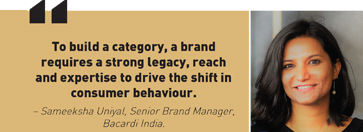

Step-by-step
Rum in India is caught in a bind with most choices in the dark rum segment hitherto available in the Rs. 400 range; or else expensive imports in the Rs. 3,000 range. As has happened with whiskey, vodka and gin, a whole ladder is emerging that enables consumers to move up step-by-step, rather than leapfrog to the top.
The same needs to develop in rum too. Keshav (The Vault) says that in most rum drinking nations, it’s ordinarily white rum that sets the base. Gautom Menon, COO of Wild Tiger Rum, agrees that white rum acts as a recruiter.
In India, although white rum may have served as the recruiter, the consumer has seen it more as an embodiment of a white spirit, and a party spirit, rather than having them develop a taste for rum.
Bacardi’s Carta Blanca white rum found favour with Indian consumers since its launch over 20 years ago. Today, Bacardi’s rum portfolio sells more than 2 million cases in India, with the lion’s share dominated by the white rum. India is, in fact, the second-largest market for rum sales for Bacardi in the world.
Bacardi also has its dark rum Bacardi Black, a set of flavoured rums and the recently launched premium Bacardi Reserva Ocho. It is a rum very much styled as either a sipping rum or else to be used as a base for a cocktail like a Rum Old Fashioned.
According to Sameeksha Uniyal, Senior Brand Manager for Bacardi in India and South-East Asia, there is a need to upgrade the perception of rum in the consumer’s mind. This is where education about its versatility and potential is critical.
Sameeksha says Bacardi is taking a bet on the category evolving fast in India, with consumers who have had superior rums overseas wanting a similar experience at home. Apart from the launch of Ocho, Bacardi plans to introduce its Anejo Cuatro and Gran Reserva Diez to India.
Emerging players
In the premium and super-premium category, apart from Ocho, there is Ron Zacapa from Diageo and Diplomatico from Venezuela (represented by Monika Enterprises). The prospects for Diplomatico hearten Kunal Patel of Monika. He says the need for a mature palate, and India’s huge whiskey-drinking base delivers that.
There is also a trio of superb rums in the form of Plantation, El Dorado and Trois Rivieres, all represented by The Vault Collection. Keshav Prakash says his rum portfolio is for the voyeur, and that there is an addressable audience for a sipping rum.
Bartenders as a community have been growing in influence in recent years in India. I anticipate that their role will be more significant when it comes to increasing rum’s share of their cocktail menu than being advocates for sipping rums.
The latter requires more customer immersion and experience. A case in point is Bacardi’s recent ‘Rum Room’ event in Delhi, Mumbai and Bengaluru. It was a combination of specially curated tastings, cocktail experiences, and music to help “first-time consumers” connect with the brand.
Bengaluru’s Ritz Carlton Hotel has launched what is probably India’s first-ever rum-focused bar, RumBah. It has a set of rum cocktails with brands from across the world and a Caribbean cuisine inspired food menu to go with it.
There is a constraint however, as regard the range of rums available. When I visited, the brand which dominated in terms of visibility was still Old Monk!
The premium and super-premium ends of the rum market have fair representation, albeit, with low volumes. But the middle ground (Rs. 600 to 2,000 price bracket) is currently sorely lacking in products.
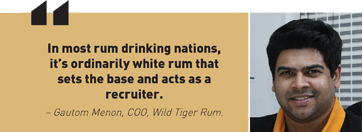
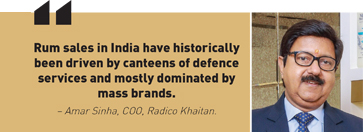
Going premium
The omen for a good quality rum that represents a significant quality and price upgrade over current brands in the dark rum segment is good. The key now is going to be the style of rum that finds success and the company/brand that tastes success.
Rum’s Global Ambassador Ian Burrell feels it’s definitely a gold rum that will make a breakthrough because customers equate the colour with it being barrel-aged, an easy parallel for the premium whisky drinker. A dark rum, he feels, conceals what’s actually in the bottle.
Gautom Menon (Wild Tiger) puts his bets on a spiced rum, given India’s long links to both spices and sugarcane. But he also has a dark and a coconut (white) rum in his portfolio.
He took an export-focused strategy with his brand and is currently available in more than 50 countries. Some of Wild Tiger products are available in a few states in India, and Gautom has plans for a wider roll-out after the pandemic.
Amrut’s Two Indies gold, as well as Radico’s Pluton Bay, a dark brown rum, are examples of Indian mid-sized companies attempting to go premium. Amar Sinha (Radico) also holds out hope for flavoured rums, infused with flavours of lime, pineapple and mango. BS Brands already has a lime flavoured white rum in the market.
Last word
Sameeksha of Bacardi feels: “To build a category, a brand requires a strong legacy, reach and expertise to drive the shift in consumer behaviour.” But in the recent past Indian consumers do not seem to have been swayed by an international brand over an Indian one.
As has been seen in single malt whisky, craft beer and now gin, the consumer is willing and open to give a quality Indian brand a fair chance. It’s also about creating micro-segments in these categories that have resonated with the customer, either from a pricing or product perspective.
Our money for the rum category to break through the stranglehold of inexpensive dark rum in India is a gold rum launched by one of the next generations of drinks entrepreneurs in India. Hopefully, we won’t have long to wait to see if our prediction comes true!











